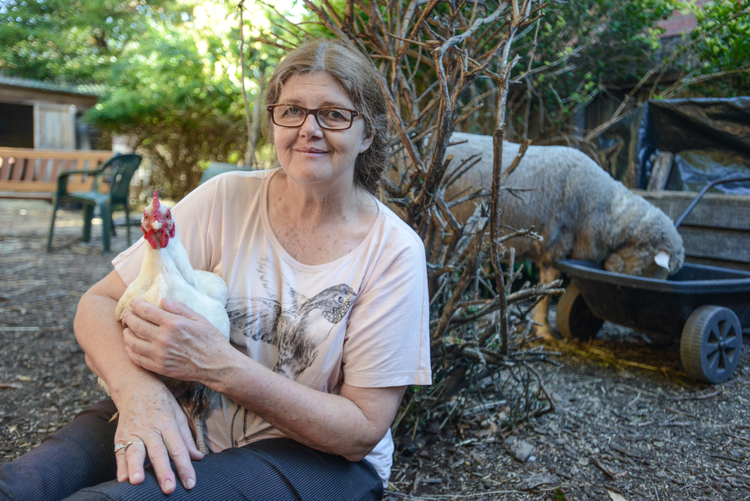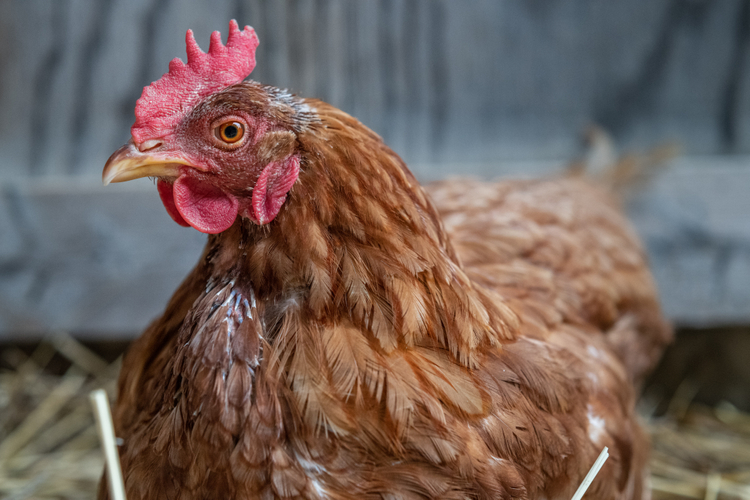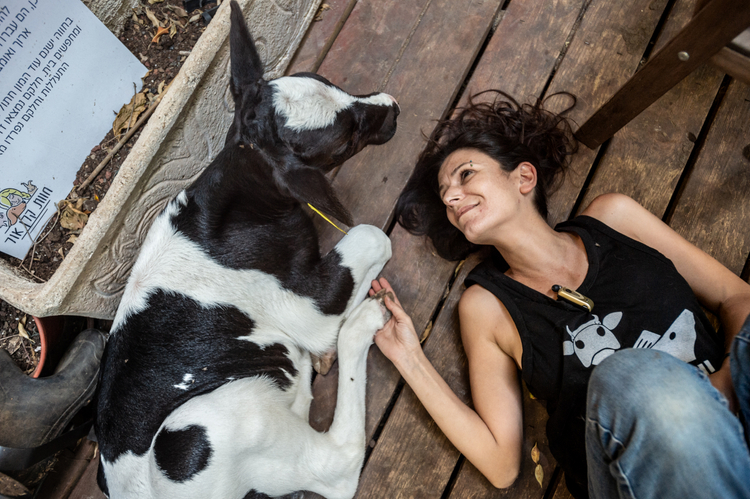When we think about the billions of animals exploited by humans, it can be hard to consider the individual. While we fight for legislative protections for animals or encourage others to give up animal products, it’s easy to lose focus on individual suffering animals, each with their own unique perspective and experience, and each worth protecting and caring for.
While activists and organizations more focused on utilitarian calculations might discount caring for individual animals as an inefficient waste of resources, others see things differently. The Microsanctuary Resource Center (MRC) provides resources for people who run microsanctuaries, which may be as small as a single rescued animal. These relationships of care are one example of what vegan/animal rights activism can look like, and are anything but small in terms of the difference they make in the lives of formerly-exploited animals.
In an interview with MRC’s co-founder and current Programs Coordinator, we discussed the concept of a microsanctuary and the role caring for individual animals plays in the overall animal liberation movement.
Dylan Forest: Your organization coined the term microsanctuary. Can we start with this concept? What is a microsanctuary, and why did you feel like this was an important concept to give a name to?
Justin Van Kleeck: A microsanctuary is any vegan home in which non-human animals who aren’t typically seen as companions, and who have been born and bred primarily for exploitation and profit, are given companion-level care for the entirety of their lives. The term and concept grew out of my and my partner’s rescue and sanctuary work focused on chickens. Our microsanctuary began in 2014 after we rescued two hens from a local shelter, thus preventing them from going back into the food system (i.e., someone’s backyard for the purpose of egg production). We didn’t have much experience with chickens (we had focused on dogs and cats in prior years) and had planned to place them with an existing vegan sanctuary, but we quickly fell in love with them and decided to change our plans. We lived on a 3-acre property and had the resources to provide a home for them, so we quickly realized that we could provide sanctuary for them. Thus was Triangle Chicken Advocates (originally Triangle Chance for All) born.
This decision made us then think about what exactly “sanctuary” meant, and how our notions of sanctuary heretofore had been entirely limited to models of existing large sanctuaries, like Farm Sanctuary, Woodstock, Animal Place, etc. These places all looked like a traditional big farm, with hundreds of animals and lofty budgets; we were just two vegans on three acres, and we didn’t want any of that.
Large sanctuaries do amazing work, but they take a lot to run and to sustain. We saw clearly that we were also providing sanctuary, but on a much different scale. My partner came up with the term “microsanctuary” to describe us, mostly as a mere descriptive term. However, once we started discussing our rescue work and our “microsanctuary,” we started to find other vegans who were caring for liberated farmed animals on their own, as they would dogs and cats. The community of microsanctuaries grew organically as more people encountered the term and felt inspired, sometimes even validated, by the self-identification of “microsanctuary.”

Why does MRC focus specifically only on microsanctuaries?
We had no idea how much the microsanctuary movement would grow back in 2014, but now it is clear that microsanctuaries are a critical component of the larger animal liberation movement. We believe that caregiving is activism, and that caregiving is vital, because physically liberating animals from exploitation is vital as one form of vegan activism. Not only do microsanctuaries (as vegan homes dedicated to the best possible care) give value to animals who are otherwise seen as mere commodities, but microsanctuaries also help to break down the speciesist barrier between “companion” and “food” animal by showing the realities of these individuals.
As an organization, we focus on microsanctuaries primarily because we believe wholeheartedly that they matter, and that growimg the community of microsanctuaries will provide more opportunities for animals in need to find safe forever homes. We strive to provide support to microsanctuaries in a variety of ways, including very small grants (which can have a huge impact for small places) to help with specific needs, mentorship, educational resources, and community forums. These resources can be particularly tailored to microsanctuaries, which often times are in urban or suburban areas and are dealing with special-needs animals, for example.
More generally, microsanctuaries often aren’t able to access individuals with years of experience in caring for these species, so we try to help them find support while also seeking to raise the bar for care standards. It may seem counterintuitive, but some of the most innovative care standards and practices are being developed by microsanctuaries, who can often hyper-focus on care for one species in ways that large sanctuaries sometimes can’t. One goal of MRC is to help support the development of best care practice and to help microsanctuaries share that knowledge with the larger community.
To some people, having a chicken microsanctuary might at first look like the same thing as the small-scale backyard chicken farming that is so popular now. Can you explain how a microsanctuary is different from the ways most people keep the same species of animals?
Let me start by saying that one of the consequences of a capitalist food system is that the vast majority of people have next to no knowledge or experience of who farmed animals are. As a result, your average person might see chickens in a backyard and think it’s amazing and happy and a great symbiotic relationship between human (farmer) and chicken (food).
The differences are stark to an experienced eye, however. For example, microsanctuaries prioritize residents’ safety and long-term health, so our standards for predator protection are much higher. There is also an expectation of providing excellent care on-site and through vets when needed. And, of course, microsanctuaries (which are by definition vegan) do not make use of the residents for food or other exploitative purposes. Eggs are fed back to the hens or prevented altogether at microsanctuaries, but the entire point of hens in backyard farm are to provide food to humans.

One of the reasons why microsanctuaries are so powerful is that they bring more farmed animals closer to more non-vegans, and thus provide more opportunities for non-vegans to see these individuals getting wonderful care, being protected, being loved and valued as family members, and living a life they might otherwise only associate with “companions” like dogs or cats. Large sanctuaries are few in number and by default in rural areas, while microsanctuaries (which can be as small as one resident) are able to operate in more densely populated areas, including cities. This means there are more opportunities for vegan activists with microsanctuaries to share the stories and experiences of their residents, and to help bust some of the many myths around exploited species.
As the name implies, Microsanctuary Resource Center makes resources available for people who care for or rescue farmed animals on a small scale. Those resources include micro-grants. Can you tell me about those grants and who they are for?
Shortly after we started MRC, we realized that there were very few places providing grant funds for farmed animal rescue. Those who did only granted money to tax-exempt non-profits. Being focused on self-reliance to a large degree, microsanctuaries may not ever pursue tax exemption, and may not seek or have luck with public fundraising. Yet even microsanctuaries have emergencies, or special projects, or other needs for support, and we wanted to develop a micro-grant program to provide help in these cases.
For the past few years, we’ve focused on small microsanctuaries and have helped both individuals and non-profits with things like reproductive healthcare, infrastructure projects, and emergency situations. This year we also launched a “Special Projects Fund” that is open to sanctuaries of all sizes, though we’ve kept the grants micro, because we want to help with concrete projects rather than larger, ongoing expenses.
There can be a tendency to think that we can either choose to focus on addressing issues on a larger, more structural level, or a smaller and more individual one. Having a microsanctuary is perhaps the most individual way one can address animal exploitation, as you’re making a difference in the lives of actual affected individual animals. What are your thoughts on the impact of having a microsanctuary vs. something larger-scale like working for legislative reform?
That’s a great question, because I’ve noticed a narrative in some circles of the vegan/animal rights movement that describes rescue and sanctuary as far too resource intensive to be worth pursuing. Personally, as a vegan of more than two decades, I feel that my going vegan “for the animals” is not separate from an obligation to individuals suffering under exploitation. Veganism is a concrete practice for me, not just about my lifestyle choices but about how I engage with the world around me, especially other living beings. If I take veganism seriously, the ethical heart of veganism forces one to question what duties we owe to put ourselves on the line for those being exploited. What work can and should we be doing to help individuals right now? I think we can both care for those in need, if we have the capacity and to what extent our capacity allows, while also thinking about bigger picture issues. The two aren’t mutually exclusive…and honestly, I have a hard time seeing the point of being vegan if I’m not thinking seriously about the individuals I am vegan “for.”

What has become so clear to me over the years is that engaging in rescue and caregiving helps me to understand more fully who these individuals are, and to understand the emotional and social lives they lead. By better understanding them and then forming a bond with them as loved ones, as family members, I see more vividly than ever just how cruel, unjust, and wrong every form of exploitation is. I can’t think about slaughterhouses or laboratories without thinking about my family members, about the hundreds of times I’ve rescued individuals from harmful situations, about the many loved ones I have lost and grieved over even while the rest of society would consider them little more than trash. What better motivation—a constant, urgent motivation—could I have to change the larger system than the well-being of my loved ones and those just like them?
Exploitation is not an abstraction. Concentrated Animal Feeding Operations and slaughterhouses are not abstractions, and they do not harm ideas. These places use and abuse and kill one individual after another, billions upon billions of times. Any one of them could be part of my family…and every one of them deserves to be treated as such.
Can you share a current example of what a microsanctuary can look like?
I’d love to highlight two of our board members, actually.
Mahika Gupta (they/them) lives in Philadelphia and has a microsanctuary. They care for a liberated hen named Corrie, who participates in Mahika’s vegan activism around the city. It’s amazing to see Mahika’s far-reaching activism and realize that Corrie the hen is right there, too, making a difference through direct connections with people. You can see posts about Corrie on Instagram at @corrielives. Mahika has been stuck in India for a few months due to COVID-19, so the account is a bit out of date, but you get the idea.
Rocky Schwartz (she/her) lives in New York City and has a microsanctuary that includes chickens, quails, fishes, and dogs. Rocky is very active doing rescue work, as well as activism in New York, and she provides both structured educational workshops on caregiving as well as informal opportunities for people to spend time with formerly exploited individuals.
While many microsanctuaries look like scaled-down versions of larger sanctuaries, the most exciting growth in the community is happening as urban vegan activists begin to liberate and care for animals.
How do specific animals end up being the ones who are rescued and cared for at a microsanctuary? For example, how does one chicken from an enormous factory farm end up being the one who is saved?
Each rescue is unique, so it’s a bit hard to generalize. In my experience, microsanctuaries are more likely to rescue animals from the local community, such as from shelters, or local residents who need to surrender an animal, or when animals are abandoned (which happens to roosters all the time). This local focus makes sense, because microsanctuaries are so community based and usually don’t have the sort of resources required to rescue from industrial farms. We more frequently deal with animals from so-called “humane” farms—small places, including backyards—and as such we can often provide unique insights into the reality behind the “humane myth.”
For readers who are interested in having a microsanctuary themselves, where would you suggest they begin in terms of preparation, and what are important considerations in terms of figuring out whether this is a reasonable responsibility to take on?
The most important place to start would be to check your local zoning ordinances and any Homeowners Association (HOA) or other neighborhood restrictions that might prohibit keeping certain species. Many towns and neighborhoods prohibit roosters, for example (which is ridiculous, but that’s how it goes). You’ll want to know about any rules or requirements before bringing these animals onto your property.
Additionally, if you don’t have much or any experience with the animals you plan to rescue, you should try to do as much preparatory research as possible, including outreach to other sanctuaries and existing online (vegan) care groups, such as Vegans with Chickens. Hands-on experience is obviously very helpful to have beforehand, if you can get it. Species bred primarily for food or other exploitative purposes frequently have a lot of particular health concerns, so it’s best to get a grasp on these before rescuing and to find a vet in your area who will treat them (as companions, not commodities).
Other than that, definitely take advantage of the existing community online and in your area if there is one. Find existing sanctuaries who discuss their care standards and provide educational information, not just cute pictures, and reach out to any vegan sanctuaries in your area who might be able to offer some support. Often times they’ll be glad to hear from you, because the need for homes is always greater than the number of sanctuary spaces.
Personally, I also find it valuable to frame caregiving as a form of vegan activism, and to make connections between why I’m vegan and why I’m providing care to these individuals. It is meaningful for our movement, and I think the better we are able to understand and represent them, the better we are able to fight for their ultimate liberation from all exploitation.
Featured image: a rescued hen in a sweater eats from a human hand. Image credit Jo-Anne McArthur / We Animals.





